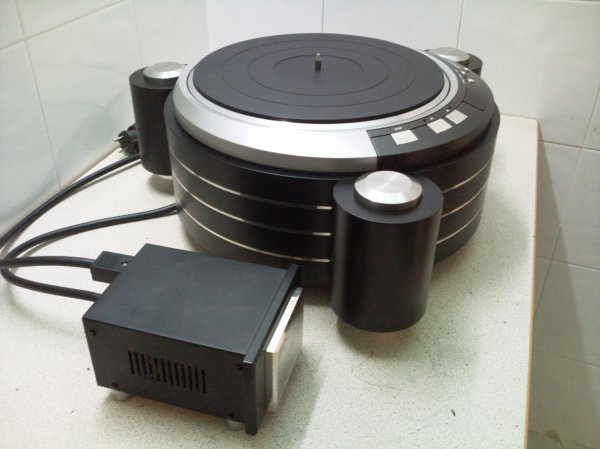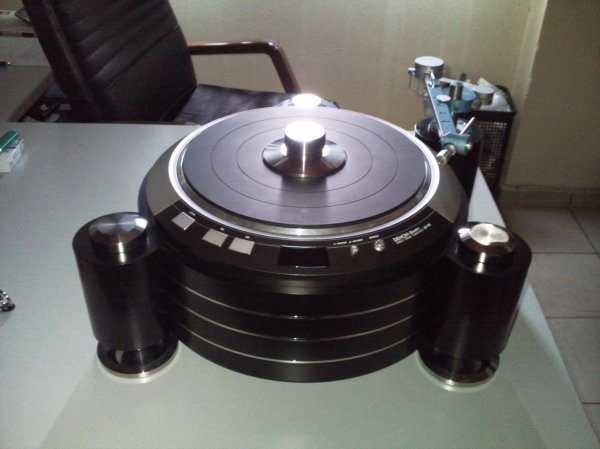I have been aproached by a friend who wanted to make a "dream" turntable on a "budget"...
After a lot of discussions we have made a plan and started "investing" on items from the second hand market.
First came the turntable:a perfect specimen of one of the top dog DD turntables that DENON made:
the DP-80.It was bought from a German lady whose "late" husband had quite a collection of turntables.
It came nicely packed with all the papers AND the original DENON cutout paper that prooved to be a great help!It was by far the best condition DP-80 that i have encountered.
Next came the tonearm:the Dynavector 507 in the rather rare light blue colour!I have seen black and silver ones but never blue!This one was bought from Denmark from a shop specialized in second hand audio items...
From a guy in Hong-Kong who has a nice ebay shop with all kinds of transformers came an over- specified one, able to convert the European 230VAC to the Japanese 100VAC.
FYI these tables were never meant to leave Japan,thus they only work on 100VAC.
I have added some extra filtering on the incoming power, added a fuse (just to be on the safe side),changed the sockets to better ones, designed a better box for it ,
and we were ready powerwise.
Last came a VdHul Condor cartridge with gold coils and low hours from a friend who upgraded to a Colibri.This was luck!He was selling the same moment we were buying!How appropriate!
I have opted for a stand alone base for the tonearm and a three legged (adjustable with spikes)
chassis for the turntable.
This chassis was made from aero grade aluminum (3 cm slabs) one on top of the other making a
hollow bowl to accommodate the motor and electronics of the DP-80.
The CNC guy found the DENON cutout print very helpful because it saved him from some very complex measurements!
Each aluminum slab was separated from the next by a 3mm soft silicone sheet and a 2mm inox
periphery ring (for decorating reasons).
Then all were screwed together with enough force so as the 3mm silicone sheet reduced it's
thickness to 2mm (as was the thickness of the inox steel rings).
All this created a mass that had damping properties incorporated inside.(Excuse my poor english!)
The three "legs" were made of bronze and where screwed to the side of the chassis,
each one with three hidden M8 screws.A silicone "gasket" was used between the base and the legs.
At the bottom of the legs a large adjustable spike and cup was used.On the top a decorative puck was milled to cover the hollow part.
The tonearm base was made from bronze too, with separate top if we ever need to change the tonearm type.
So all the "shining" parts you see are from polished inox steel.Black parts are either aluminum or bronze.
I have added a sheet of self adhesive neoprene on the sides and bottom of the "bowl"
that covers the motor and electronics of the DP-80.This sheet needed to compress a bit in order
to fit inside the base opening.
This way we have achieved to eliminate a major problem of the original DENON design:the ringing of the
sheet steel that covers the electronics.
Last i have inverted the Denon chassis and filled all the die-cast cavities of the periphery of the turntable with a kind of resin that behaves like dried tar-nasty stuff but heavy and perfect for damping vibrations.
It took the force of two strong people to push the DP-80's bottom into the base,but when it hit
bottom you could feel that even without the securing screws it was a veeeery tight fit.
Last thing i did was to design a large heavy (750gr) record pressing weight with a 2mm soft silicone sheet glued under it.
I think it looks like a million bucks and first listening impressions justify the cost and effort involved.(The whole project from start to finish took five months)
The pictures are from my phone and don't do it justice!What do you think?
I advised him to find a gun metal record mat that Micro Seiki was making to incorporate it
under the Denon rubber mat, to increase the inertia of the rotating mass but even as it is it's rotational stability
is like nothing i have seen!You have to see it with your own eyes to believe how fast it accelerates to 45rpm
or slows down to 33rpm (it has an electronic brake!).
It's because of the huge motor (it looks like a starting motor of a truck!) that rotates the platter and the bi-directional servo control that has an iron grip on the platter speed.
A thing of beauty!If i wasn't neck deep into a different approach to turntable design, i would make my own just like this!
After a lot of discussions we have made a plan and started "investing" on items from the second hand market.
First came the turntable:a perfect specimen of one of the top dog DD turntables that DENON made:
the DP-80.It was bought from a German lady whose "late" husband had quite a collection of turntables.
It came nicely packed with all the papers AND the original DENON cutout paper that prooved to be a great help!It was by far the best condition DP-80 that i have encountered.
Next came the tonearm:the Dynavector 507 in the rather rare light blue colour!I have seen black and silver ones but never blue!This one was bought from Denmark from a shop specialized in second hand audio items...
From a guy in Hong-Kong who has a nice ebay shop with all kinds of transformers came an over- specified one, able to convert the European 230VAC to the Japanese 100VAC.
FYI these tables were never meant to leave Japan,thus they only work on 100VAC.
I have added some extra filtering on the incoming power, added a fuse (just to be on the safe side),changed the sockets to better ones, designed a better box for it ,
and we were ready powerwise.
Last came a VdHul Condor cartridge with gold coils and low hours from a friend who upgraded to a Colibri.This was luck!He was selling the same moment we were buying!How appropriate!
I have opted for a stand alone base for the tonearm and a three legged (adjustable with spikes)
chassis for the turntable.
This chassis was made from aero grade aluminum (3 cm slabs) one on top of the other making a
hollow bowl to accommodate the motor and electronics of the DP-80.
The CNC guy found the DENON cutout print very helpful because it saved him from some very complex measurements!
Each aluminum slab was separated from the next by a 3mm soft silicone sheet and a 2mm inox
periphery ring (for decorating reasons).
Then all were screwed together with enough force so as the 3mm silicone sheet reduced it's
thickness to 2mm (as was the thickness of the inox steel rings).
All this created a mass that had damping properties incorporated inside.(Excuse my poor english!)
The three "legs" were made of bronze and where screwed to the side of the chassis,
each one with three hidden M8 screws.A silicone "gasket" was used between the base and the legs.
At the bottom of the legs a large adjustable spike and cup was used.On the top a decorative puck was milled to cover the hollow part.
The tonearm base was made from bronze too, with separate top if we ever need to change the tonearm type.
So all the "shining" parts you see are from polished inox steel.Black parts are either aluminum or bronze.
I have added a sheet of self adhesive neoprene on the sides and bottom of the "bowl"
that covers the motor and electronics of the DP-80.This sheet needed to compress a bit in order
to fit inside the base opening.
This way we have achieved to eliminate a major problem of the original DENON design:the ringing of the
sheet steel that covers the electronics.
Last i have inverted the Denon chassis and filled all the die-cast cavities of the periphery of the turntable with a kind of resin that behaves like dried tar-nasty stuff but heavy and perfect for damping vibrations.
It took the force of two strong people to push the DP-80's bottom into the base,but when it hit
bottom you could feel that even without the securing screws it was a veeeery tight fit.
Last thing i did was to design a large heavy (750gr) record pressing weight with a 2mm soft silicone sheet glued under it.
I think it looks like a million bucks and first listening impressions justify the cost and effort involved.(The whole project from start to finish took five months)
The pictures are from my phone and don't do it justice!What do you think?
I advised him to find a gun metal record mat that Micro Seiki was making to incorporate it
under the Denon rubber mat, to increase the inertia of the rotating mass but even as it is it's rotational stability
is like nothing i have seen!You have to see it with your own eyes to believe how fast it accelerates to 45rpm
or slows down to 33rpm (it has an electronic brake!).
It's because of the huge motor (it looks like a starting motor of a truck!) that rotates the platter and the bi-directional servo control that has an iron grip on the platter speed.
A thing of beauty!If i wasn't neck deep into a different approach to turntable design, i would make my own just like this!
Attachments
Last edited:






